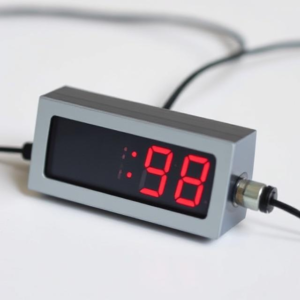What is an Oscillator?
First, let’s understand what an oscillator is. An oscillator is an electronic circuit or device that generates a repeating wave, typically a sine wave or square wave. This repeating wave can be used as a time reference in many electronic devices, such as clocks, radios, and computers.
Now, to generate these waves accurately, we need something that can produce a stable frequency (the rate at which the wave repeats). This is where crystals and resonators come into play.

What is a Crystal Oscillator?
A crystal oscillator is a type of oscillator that uses a quartz crystal to generate a precise frequency. The key component here is the quartz crystal, which vibrates at a specific frequency when an electric current is applied.
- Quartz Crystal: Quartz is a type of mineral that has special properties. When you apply an electric voltage to a quartz crystal, it vibrates at a specific frequency. This property is called the piezoelectric effect. The frequency at which it vibrates depends on the size and shape of the crystal.
How Does a Crystal Oscillator Work?
- Quartz Crystal: The quartz crystal is the core part of the oscillator. It vibrates when a small electrical current is applied. This vibration happens at a very precise frequency.
- Amplification: The vibrating crystal creates a small signal. This signal is then amplified by the oscillator circuit, which makes the signal stronger.
- Feedback: The amplified signal is fed back into the crystal, causing it to continue vibrating, which maintains the oscillation (the repeating wave). This process keeps the signal going.
- Stable Frequency: Because quartz crystals are very precise, they produce a stable and reliable frequency, which makes them ideal for use in clocks, watches, and other timing applications.
Why is a Crystal Oscillator Important?
- Precision: The main advantage of crystal oscillators is their ability to generate very accurate and stable frequencies. This makes them essential for things like keeping time in digital watches, controlling frequencies in radios, and syncing the operations in computers.
- Reliability: Crystals are reliable and can operate for many years without much drift or variation in their frequency.
- Widely Used: They are used in almost all electronic devices that need to measure or control time accurately, such as computers, smartphones, GPS systems, and more.
What is a Resonator?
A resonator is similar to a crystal oscillator but usually simpler and less precise. Resonators also generate oscillations, but instead of using a quartz crystal, they often use ceramic materials or other structures to create a resonating effect.
- Ceramic Resonator: These are made of ceramic materials and can be used to generate a frequency when they vibrate. They work on a similar principle to the quartz crystal, but ceramic resonators tend to be less accurate and more affordable.
- Resonance: A resonator works based on the principle of resonance. When an object (like a ceramic resonator) is exposed to a certain frequency, it naturally vibrates at that frequency. The resonator is designed to vibrate at a specific frequency, and this vibration is used to generate the oscillation.
How Does a Resonator Work?
- Vibration: The resonator (often ceramic) vibrates when an electrical current is applied. Just like the crystal, this vibration happens at a specific frequency.
- Amplification and Feedback: The oscillation signal is then amplified and fed back into the resonator to maintain the oscillation, similar to how a crystal oscillator works.
Differences Between Crystal Oscillators and Resonators:
| Feature | Crystal Oscillator | Resonator |
|---|---|---|
| Material | Uses quartz crystals (very precise) | Uses ceramic or other materials (less precise) |
| Precision | Very accurate and stable frequency | Less accurate and stable than crystal oscillators |
| Cost | More expensive due to precise manufacturing | Cheaper and simpler to make |
| Applications | Used in clocks, watches, computers, and radios | Often used in low-cost devices where precision isn’t critical |
When to Use a Crystal Oscillator vs a Resonator?
- Use a crystal oscillator when you need high precision and stability in your timing or frequency generation. For example, in applications like digital watches, GPS systems, or computers, where accurate timing is critical.
- Use a resonator when cost is a key factor and the required frequency stability is not as strict. For example, in some low-cost electronics or simple devices like basic toys or inexpensive gadgets.
Why Are They Both Important?
- Crystal Oscillators are important for high-precision applications where accuracy is essential, like in communication systems or digital clocks.
- Resonators are used in low-cost, simple devices where perfect accuracy isn’t as critical but still provides a good enough frequency reference for basic tasks.
Summary:
- Crystal Oscillators: Use a quartz crystal to generate very accurate and stable frequencies. They are essential in devices that require precise timing, like watches, clocks, and computers.
- Resonators: Use materials like ceramics to generate oscillations, but they are less precise than crystal oscillators. They are cheaper and often used in simpler, low-cost applications.
Both crystal oscillators and resonators are fundamental for generating consistent timing and frequencies in electronics, but the choice between them depends on the precision required and the cost constraints of the application.











